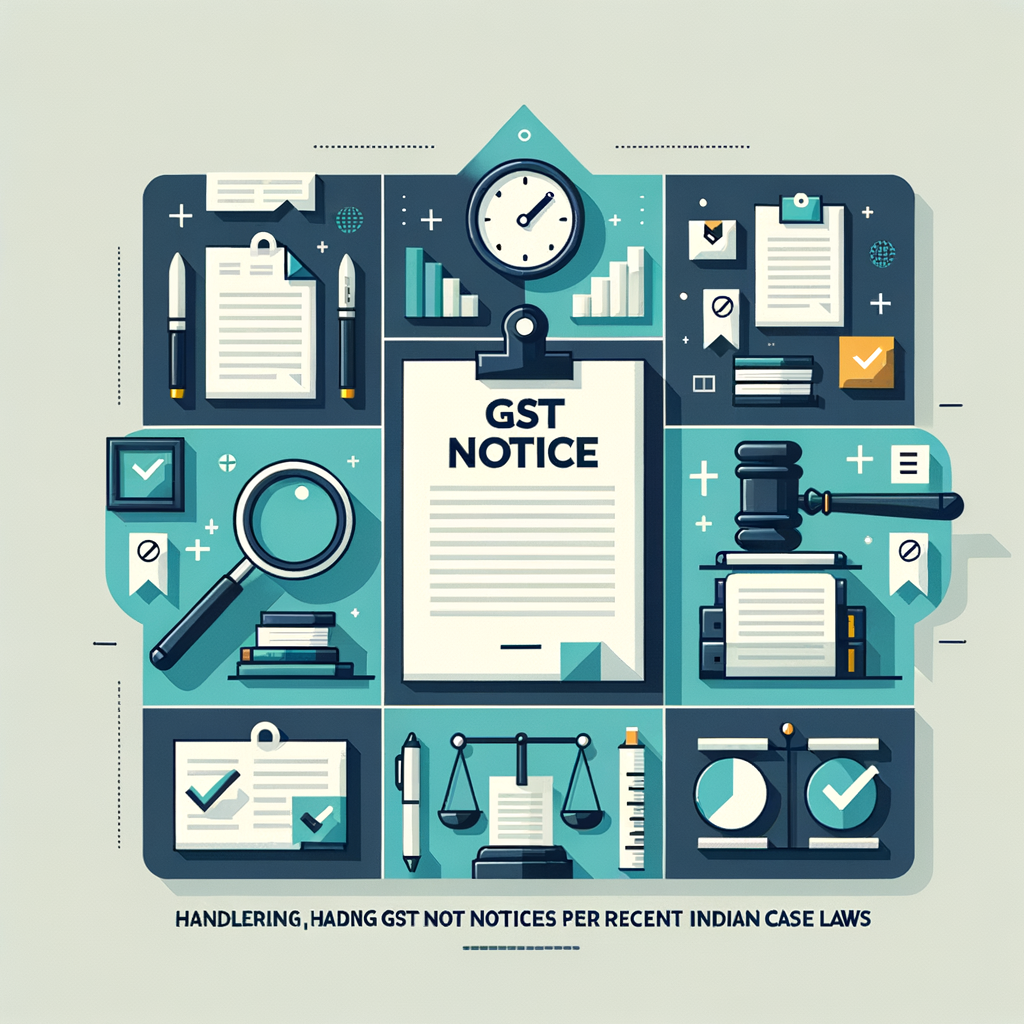Practical Tips for Handling GST Notices Based on Recent Case Laws
That official-looking envelope from the GST department can send a wave of anxiety through any business owner. Your mind races with questions: What did I do wrong? Is this a major problem? While a GST notice is certainly something to take seriously, it is often a manageable issue with the right knowledge and a methodical approach. The key to a successful response often lies not just in your business records, but in understanding how similar issues have been interpreted by the courts. This article provides practical, step-by-step guidance on handling notices based on case laws, empowering you to navigate this process with confidence and turn a potential challenge into a demonstration of your compliance.
First Things First: Understanding Why You Received a GST Notice
Before you can formulate a response, you need to understand the root cause. GST authorities use automated systems to flag discrepancies, and a notice is simply the department’s way of asking for clarification. Understanding the common triggers can help you identify potential compliance gaps in your own processes and prepare a more effective reply. These insights are some of the most crucial GST notices handling tips for businesses India.
Common Reasons for GST Notices
The GST regime is data-intensive, and most notices arise from mismatches in the information reported by you and your suppliers or customers. Here are some of the most frequent triggers:
- Mismatch in GSTR-1 and GSTR-3B: The tax liability declared in your summary return (GSTR-3B) does not match the outward supplies detailed in your GSTR-1.
- Discrepancies in Input Tax Credit (ITC): The ITC you claimed in your GSTR-3B is more than what is auto-populated in your GSTR-2B or GSTR-2A.
- Delay or Non-filing of GST Returns: Consistently filing returns late or not filing them at all is a major red flag for the department.
- Incorrectly Claiming a Refund: The department may issue a notice if they find discrepancies in your refund claim application and the data on record.
- Non-compliance with E-invoicing/E-way Bill Rules: Failure to generate e-invoices for B2B transactions (if applicable) or transport goods without a valid e-way bill.
Key Types of Notices to Know
GST notices come in various forms, each with a specific purpose. Understanding the type of notice you’ve received is the first step in crafting the right response.
- ASMT-10: This is a scrutiny notice issued when the officer finds a discrepancy in your returns. It’s a request for an explanation and is not a demand for tax.
- SCN (Show Cause Notice): This is a more serious notice, issued before a demand for tax is confirmed. It asks you to “show cause” why a certain tax, interest, or penalty should not be levied on you.
- DRC-01: This is a summary of the Show Cause Notice, which electronically details the proposed tax demand and penalty.
You can always log in to the official GST Portal to view any notices issued to you and check your overall compliance status.
The Power of Precedent: Why Case Laws are Your Secret Weapon
Once you understand the ‘what’ and ‘why’ of your notice, the next step is to build a strong ‘how’ for your reply. This is where legal precedents become invaluable. While your own documents are the foundation of your defense, case laws provide the legal framework and authority to support your position, making them essential for effectively handling notices based on case laws India.
What is a “Case Law” in the GST Context?
In simple terms, a case law, also known as a judicial precedent, is a judgment or a ruling delivered by a High Court or the Supreme Court on a specific legal question or issue. These rulings are not just opinions; they create a legal principle that tax officers and lower courts are expected to follow in future cases that involve similar facts and legal questions. For example, if a High Court rules that a specific type of service is exempt from GST, that ruling becomes a case law that other taxpayers in similar situations can cite.
How Case Laws Can Strengthen Your Response
Relying solely on your own interpretation of the GST Act can be risky, as a tax officer may have a different view. Citing a relevant case law fundamentally changes the nature of your argument.
- Provides a Strong Legal Foundation: Instead of just saying, “I believe I am correct,” you can state, “My position is correct, and it is supported by the ruling of the Hon’ble High Court in this particular case.” This adds immense weight to your reply.
- Shows the Officer Your Position is Vetted: It demonstrates that you have done your homework and that your interpretation of the law has already been upheld by a higher judicial authority.
- Challenges Incorrect Interpretations: Sometimes, notices are issued based on an overly strict or incorrect interpretation of the law by the local tax authority. Case laws are the perfect tool for managing GST notices based on case laws because they can effectively counter such interpretations with the power of a judicial verdict.
Your Step-by-Step Guide: Practical Tips for Handling Notices Based on Case Laws
Responding to a GST notice is a systematic process. By following these steps, you can ensure your reply is timely, comprehensive, and legally sound, leveraging the power of judicial precedents to your advantage.
Step 1: Acknowledge and Analyze the Notice Immediately
Procrastination is your worst enemy when it comes to legal notices. The moment you receive it, you must act.
- Do Not Ignore: Never put the notice aside to deal with later. The clock is ticking.
- Check Critical Details: Carefully read the entire notice and identify the following:
- Deadline for Response: This is the most crucial piece of information. Mark it on your calendar immediately.
- Document Identification Number (DIN): Ensure the notice has a valid, computer-generated DIN. As per government circulars, a notice without a DIN may be considered invalid.
- Specific Discrepancy: Understand exactly what the officer is questioning. Is it an ITC mismatch, a valuation issue, or something else?
Step 2: Collate All Your Documents and Evidence
Your reply is only as strong as the evidence you provide to support it. Begin gathering all relevant documents to build a factual foundation for your case.
- Essential Documents:
- Copies of relevant tax invoices (both sales and purchases).
- Copies of your GSTR-1, GSTR-3B, and GSTR-2B/2A for the period in question.
- Bank statements showing proof of payment for the transactions under scrutiny.
- Copies of e-way bills, delivery challans, or lorry receipts to prove the movement of goods.
- Any contracts, agreements, or email communications with the supplier or customer that are relevant to the case.
Step 3: Research Relevant Case Laws
This is where you move from a purely factual defense to a legally fortified one. Here is some practical advice for legal notices:
- Identify the Legal Question: Based on the notice, pinpoint the exact legal issue. For instance, is the issue about the eligibility of ITC when the supplier hasn’t paid tax? Or is it about the time limit for claiming ITC?
- Search for Precedents: Look for judgments from High Courts or the Supreme Court that have addressed this same legal question.
- Example 1 (ITC Mismatch): Suppose you receive a notice to reverse Input Tax Credit because your supplier’s invoice isn’t reflecting in your GSTR-2A. However, you have the original tax invoice, proof of payment to the supplier through your bank, and proof that you received the goods. You can cite recent High Court rulings (e.g., cases like Diya Agencies v. State Tax Officer) where courts have held that ITC cannot be denied to a genuine buyer if they can prove the bona fides of the transaction, even if the supplier has defaulted.
- Example 2 (Minor Procedural Error): Imagine a notice is issued for a minor clerical error in an e-way bill, like a one-digit typo in the vehicle number. You can research and cite judgments where courts have ruled that substantive benefits (like the free movement of goods) cannot be denied for trivial, non-fraudulent procedural lapses, and a minor penalty might be applicable instead of a major one.
Step 4: Draft a Detailed, Factual, and Legally Sound Reply
Your written response is your official statement. It needs to be clear, professional, and persuasive.
- Structure Your Reply:
- Acknowledge the Notice: Start by referencing the notice number and date.
- Point-by-Point Rebuttal: Address each and every allegation or query raised in the notice separately. Do not club answers together.
- Present Your Facts: For each point, state your case clearly and concisely.
- Attach Evidence: Refer to your supporting documents as annexures (e.g., “A copy of the tax invoice is attached as Annexure-A”).
- Cite the Case Law: This is the crucial part. After presenting your facts for a particular point, write a paragraph explaining the relevant case law. For example: “Our position is supported by the judgment of the Hon’ble Madras High Court in the case of [Case Name], where it was held that… The facts of our case are similar to this ruling, and therefore, the proposed demand is not tenable.”
Step 5: Know When to Seek Professional Help
While you can handle simple queries yourself, it’s wise to recognize when you need an expert. These are some of the most important tips for handling legal notices India:
- Complex Cases: If the notice involves complex legal interpretations, anti-profiteering, or classification disputes, it’s best to consult a professional.
- High-Value Demands: When the tax amount at stake is significant, the cost of professional advice is a small price to pay to avoid a large liability.
- Ambiguous Law: If the legal position is unclear or there are conflicting judgments, an expert can help you navigate the ambiguity. Seeking recent case laws consultation India from a qualified Chartered Accountant or a Tax Lawyer can make all the difference. Their expertise provides the best practical tips for handling notices.
Common Pitfalls to Avoid When Responding
How you respond is just as important as what you say. A single mistake can weaken your entire case. Be sure to avoid these common errors:
- Missing the Response Deadline: This is the biggest mistake. It can lead to an ex-parte order (an order passed without hearing your side), with the officer confirming the entire proposed demand.
- Submitting an Incomplete or Vague Reply: A reply that says “we have complied with all laws” without any supporting evidence is as good as no reply.
- Making Emotional or Aggressive Statements: Always maintain a professional and respectful tone in your written reply.
- Failing to Address All Points: Ensure you have responded to every single query raised in the notice. Leaving a point unanswered can be interpreted as your acceptance of that allegation.
- Ignoring the Power of Legal Precedents: Not citing relevant case laws is a missed opportunity to build a rock-solid defense.
Conclusion
Receiving a GST notice doesn’t have to be a cause for panic. By viewing it as a request for information, you can approach it with a clear and strategic mindset. The key takeaways are simple: act promptly, be meticulous with your documentation, and most importantly, use the power of legal precedents to your advantage. A well-prepared, evidence-backed response that is fortified with relevant case law is your strongest defense. Effective handling of notices based on case laws can not only resolve the immediate issue but also prevent future litigation and unnecessary financial burdens on your business.
Feeling overwhelmed by a GST notice? Let the experts at TaxRobo help. Our team specializes in tax litigation and offers recent case laws consultation India to build you a robust case. Contact us today for a consultation.
Frequently Asked Questions (FAQs)
1. What is the very first thing I should do after receiving a GST notice?
Answer: Do not panic. Carefully read the notice to understand the issue and, most importantly, note the deadline for filing your reply. Acknowledging the notice on the GST portal (if required) is also a critical first step.
2. Can I respond to a GST notice myself without a professional?
Answer: For simple procedural notices, you may be able to respond yourself. However, for complex issues involving legal interpretation, large tax amounts, or show-cause notices, seeking professional help is highly recommended to avoid adverse orders.
3. What happens if I ignore a GST notice?
Answer: Ignoring a notice can lead to serious consequences, including the tax officer making a “best judgment assessment” against you, imposing hefty penalties, initiating recovery proceedings, and even prosecution in some cases.
4. Where can I find reliable GST case laws?
Answer: While some judgments are available on court websites, specialized legal databases and tax journals are the most reliable sources. Consulting with a tax professional from TaxRobo can give you access to the most relevant and recent case laws for your specific situation.



